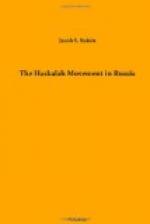The book was finished in 1823, but, owing to Levinsohn’s pecuniary circumstances, it remained unpublished till 1828. Meanwhile it circulated in manuscript among the leading Maskilim of Russia, Austria, and Germany, and established its author’s reputation wherever it was read. Levinsohn was one of those who understand the persuasive power of the still small voice of sweet reasonableness. He knew that a few convincing arguments couched in gentle language will accomplish more for the furtherance of an ideal than the trumpet call of a hundred clamoring militants, and Haskalah will make headway only when it can prove itself to be a help, and not a hindrance, to religion. Accordingly, he aimed to show that the Tanaim, Amoraim, Saboraim, Geonim, and rabbis of later generations were versed in the sciences, were familiar with foreign history, and interested in the affairs of the world. But these he quotes only as exemplars of broad-mindedness, they must no longer be regarded as authorities in secular knowledge. “Art and science,” he says, “are steadily progressing.... To perfect ourselves in them we must resort to non-Jewish sources.” This was a bold statement for those times, however mildly expressed. The Te’udah became a bone of contention. It was torn and burnt by fanatics, exalted to the skies by friends. The new apostle of enlightenment was forced to leave the city and reside for a while in Berdichev, Nemirov, Ostrog, and Tulchin. But wherever he went, his tribulation was sweetened by the enthusiasm of his admirers and the consciousness that his toil was not entirely wasted. In Warsaw and in Vilna his name was great, and Nicholas presented him with a thousand rubles as a mark of appreciation of the book, the fly-leaf of which bears the inscription “To science.”
In the midst of his more serious studies Levinsohn diverted himself occasionally with lighter composition, in which many an antiquated custom served as the butt for his biting satire. In his youth he had a penchant for poetry, and his poem on the flight, or expulsion, of the French from Russia was complimented by the Government. His muse dealt with ephemeral themes, but his bons mots are current among his countrymen to this day. A novel sort of plagiarism was the fashion of the time. Authors attributed their work to others, instead of claiming the product of others as their own. Levinsohn’s Hefker Welt, in Yiddish, and Sayings of the Saints and Valley of the Dead, in Hebrew, belong to this category. But the deep student did not persist long in this species of diversion. Wittgenstein, the field-marshal, and professors at the Lyceum of his town, supplied him with books, and he, an omnivorous reader, plunged again into his graver work, the result of which was the little book since translated into English, Russian, and German, Efes Dammim (No Blood!). As the name indicates, it was intended as a defence against the blood, or ritual murder, accusation.




